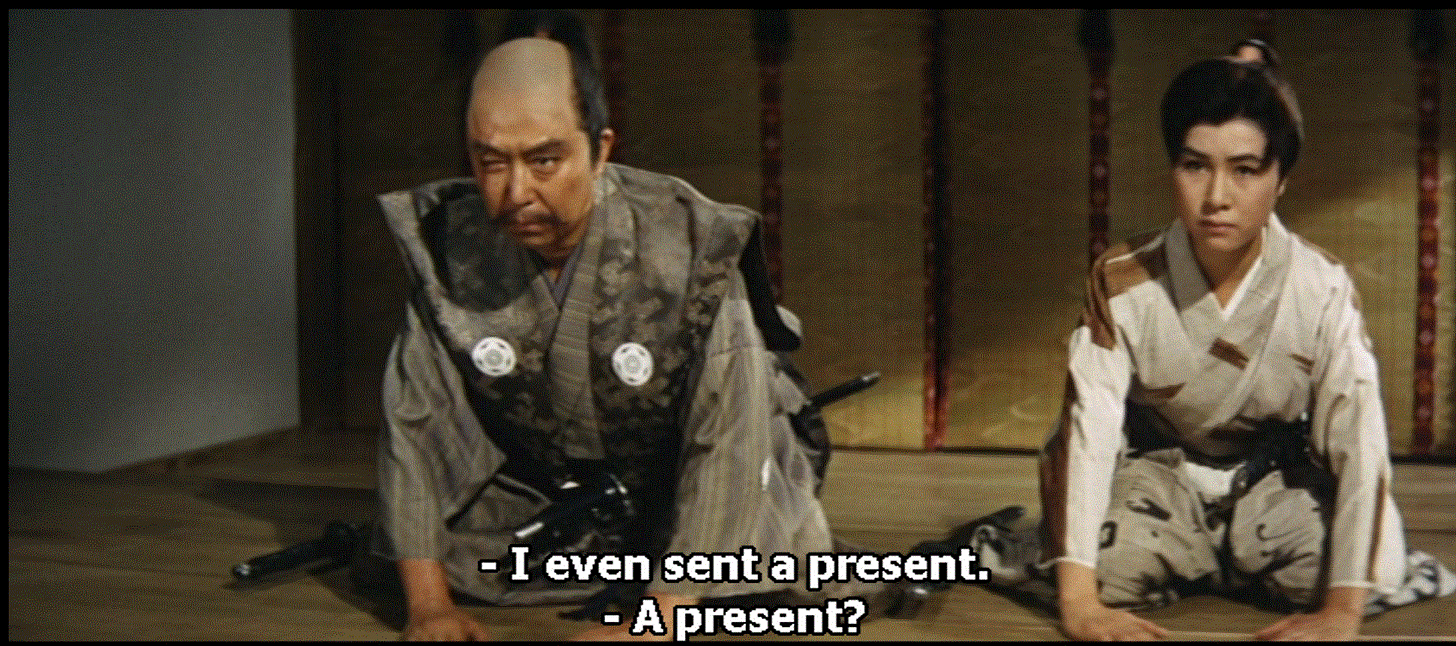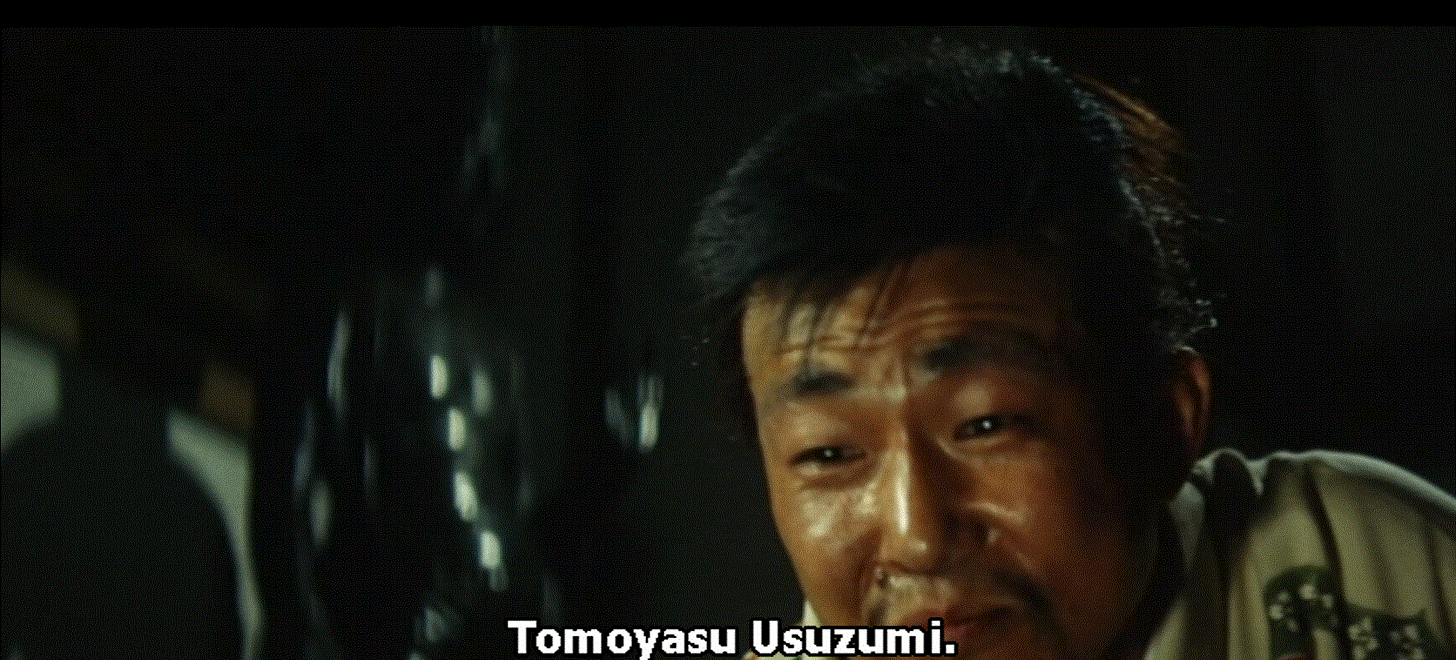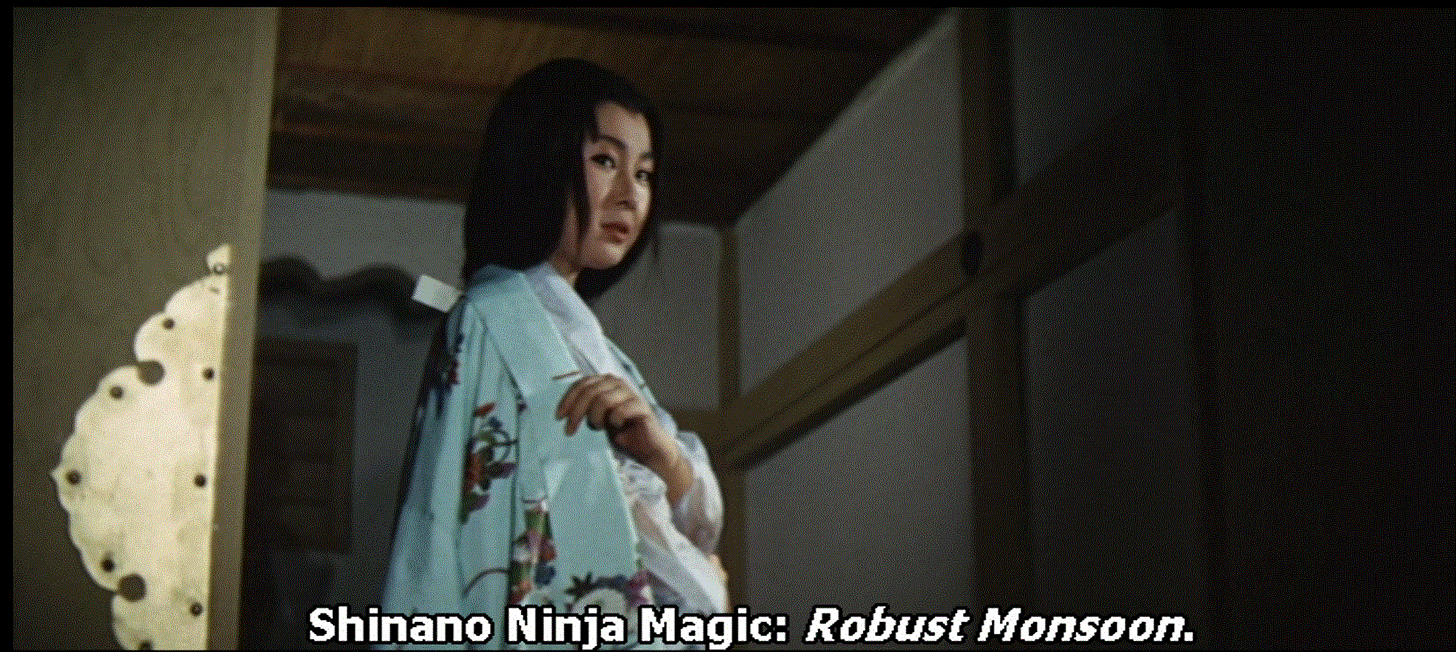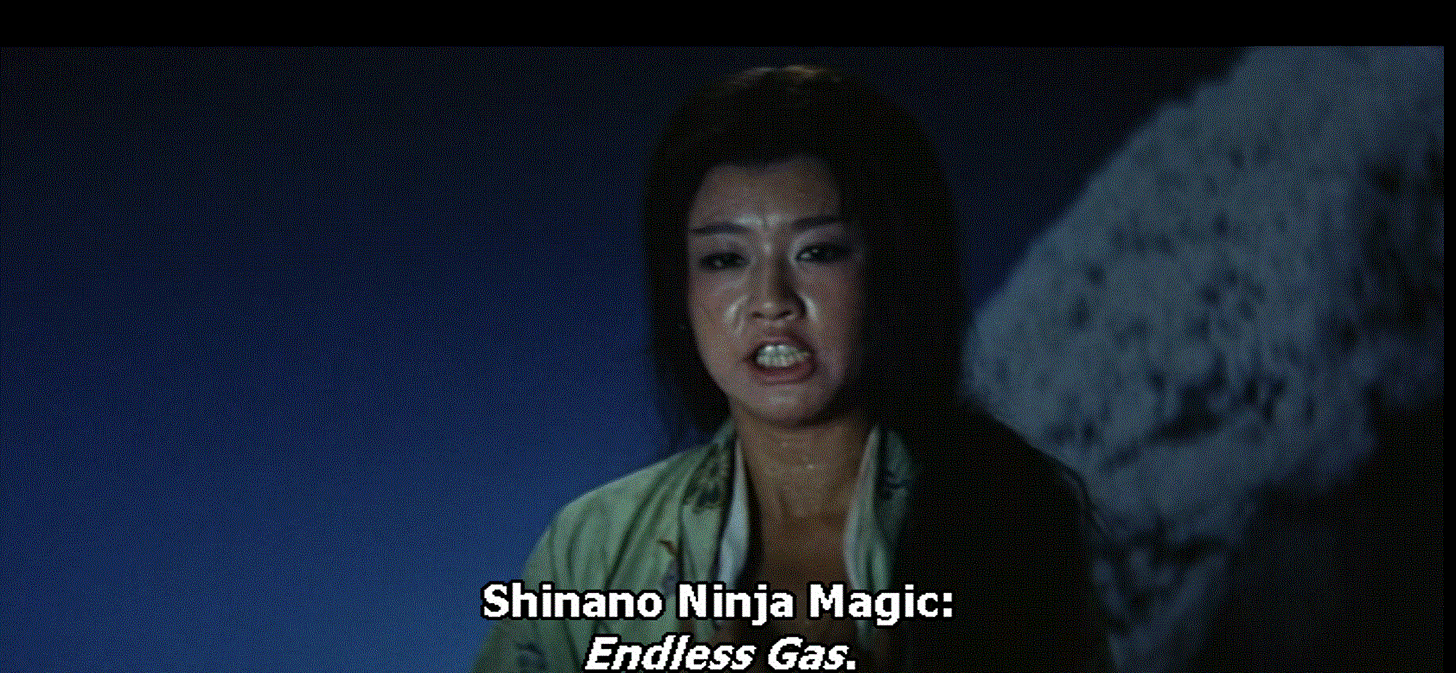A Ninja's Guide to Dismantling the Patriarchy
The gonzo set-pieces of 'Ninja Lady Magic' (1964)

Last time around we introduced the 1964 film Ninja Lady Magic (Kunoichi ninpō), a frankly baffling adaptation of the popular Japanese writer Yamada Fūtarō’s novel Kunoichi ninpōchō (‘The Ninja Lady Magic Scrolls,’ 1960-61).1 We’re interested in this film because it was probably the work that established the idea that the word kunoichi meant “female ninja,” even though the word isn’t used that way in the film itself.
Our adventure has begun in 1615 with what appears to be destruction of the house of Toyotomi at the hands of the Tokugawa clan. The Tokugawa victory is not complete, however, since the recently-deceased Toyotomi clan head, Hideyori, has left behind a potential heir. This heir is being carried in the womb of none other than Lady Sen, daughter of the Tokugawa clan head Tokugawa Ieyasu.2 Ieyasu must therefore try to thread the needle of disposing of the unborn child and finishing the Toyotomi off once and for all, while also making sure not to harm his daughter. Naturally, this is the sort of mission you need a ninja for, so Ieyasu reaches out to some men from Iga to get the job done.
The Female Of The Species…
So is set the stage for an epic confrontation between the five male Iga ninja that Ieyasu has hired and the five Shinano ninja left behind by Sanada Yukimura to protect Lady Sen.3 This will not be a contest of physical skills - no shuriken throwing involved. Instead, what passes for the plot of the film will mostly involve set-pieces showcasing several different forms of Iga and Shinano ninja magic. The majority of these, to nobody’s very great surprise, involve sex in some way.
The female Shinano ninja, notably, have a variety of spells that drive men mad with lust and then kill them when they attempt to act on said lust. Shortly after the Iga ninja are given their mission, we cut to Lady Sen receiving a party of male samurai from the lord Ieyasu wants her to marry. Lady Sen tells the samurai representatives to take a hike, that she’s not marrying anyone, and as she does so one of her attendants unveils a seemingly innocuous statue of Kannon, Buddhist goddess of mercy:
The effect is immediate and dramatic; the male samurai start almost literally drooling, and, rendered thus defenseless, are killed and dumped down a nearby well. This, we learn, was the lethal:
Shortly after this, one of the male Iga ninja manages to kill one of Lady Sen’s maids and assume her shape. Coming across another one of the maids, he’s overcome with lust himself and changes back to his original male form in order to force himself on her:
Usuzumi then changes into her shape and continues with his mission - but the ninja is not as defenseless as she might have seemed, since using her magic she put a mark on Usuzumi’s forehead that immediately makes his real identity clear even when transformed:
With his cover blown, Usuzumi is swiftly dispatched by the surviving Shinano women.
Is That What They’re Calling It Now?
The above only scratches the surface of the ninja magic hi-jinks. Not long after Usuzumi’s demise, a samurai named Jūbei comes calling on Lady Sen to try to find out what happened to the earlier marriage representatives:

The ol’ Kannon statue presently comes out, but Jūbei isn’t simply killed. A significantly worse fate awaits this grizzled warrior, whom we see shortly afterward looking distinctly the worse for wear:
He has, you see, been subjected to a particularly terrifying form of Shinano ninja magic:
The subtitler seems to have gotten the name of the spell wrong, for what it’s worth - it’s supposed to be “withered stalk” (tsutsu-karashi), but I think it was misheard as tsuyu korashi, which would indeed mean something like “concentrated monsoon.”4
It’s so important to be precise about these things.
[Edited 6/11 - no, I stand corrected. It actually is supposed to be tsuyu, only it’s “dew” (露) rather than ‘monsoon.’ The director changed it, I just learned.]
What does the “withered stalk” spell actually do? Well, you can read about it for yourself in Matt Alt and Yoda Hiroko’s 2012 ninja book.
A Labor of Love
I could go on, but by now you’ve probably got enough of a sense of how the film as a whole is constructed. We don’t so much have a developed plot as we do a series of set-pieces designed to show off each side’s ninja magic, which depending on your tastes you’ll find either mildly hilarious or frankly kind of icky.
To cut a long and incoherent story short, none of the Iga ninja actually succeed in harming Lady Sen, but they do manage to kill off her attendants one by one. Realizing that the odds of their survival are worsening by the moment, the Shinano ninja hit upon a novel way to protect the Toyotomi heir - by making sure that the enemy doesn’t know which of the surviving women is actually pregnant. This they will do by magically transferring the baby from one womb to another:
This immediately made me think of Changing Rooms, a very popular home improvement and interior design show in the UK back when I still lived there. I also love Lady Sen’s expression (Nogawa Yumiko, on the left). Perhaps her agent just walked onto set and she was trying to signal to him we need to talk.
As the film nears its end, Lady Sen and her surviving attendant - who, thanks to the Changing Rooms magic is actually carrying the baby - flee into the snowy mountains to try to get away from their pursuers. A squad of Iga ninja closes in on them just as the attendant is going into labor, but despite the pain she digs deep for one last burst of ninja magic:
The magical poison gas kills off most of the pursuing enemy ninja, and the day is finally saved when one of the last two Iga ninja switches sides, having been impressed by Lady Sen’s fortitude and fallen in love with her:
The ensuing duel, however, proves fatal for both men, so Lady Sen is the last woman standing and is left to embrace her newborn child in (relative) peace.
So there we go. After all that nonsense, both Lady Sen and her baby survive. In the next post, we’ll wrap up by looking at the last few moments of the film, and answer perhaps the most pressing question of all, which is: what the hell was that all about?
Kunoichi ninpōchō くノ一忍法帖 (pub. 1960-61); Yamada Fūtarō 山田風太郎 (1922-2001).
As I noted last time around Lady Sen did exist, but was in reality Ieyasu’s grand-daughter. Born in 1597, she was only seven when she was married to Hideyori in 1614, very much as a political marriage. Presumably the film changes her to Ieyasu’s daughter to make her old enough to have children.
Shinano Province 信濃 was Sanada Yukimura’s base. It’s in the mountains of central Japan, roughly modern Nagano Prefecture.
Japanese: 筒涸らし (tsutsu-karashi) vs. (?) 梅雨凝らし (tsuyu-korashi). I checked the text of the original novel to confirm.
28 years of Japanese language study justified right here, thank you very much.













Well, yes, what the hell was that all about? 🥷
When you put it that way it sounds like someone wrote it while spiking a fever of 104